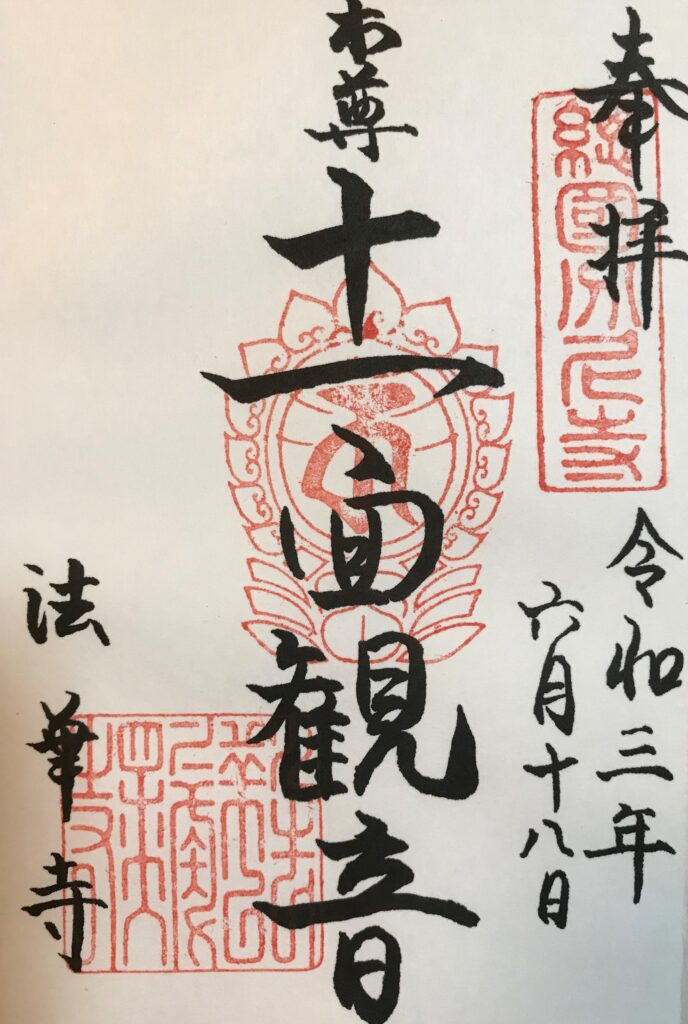総国分尼寺の法華寺
海龍王寺から少し歩くと法華寺に到着します。この法華寺も奈良時代の創建です。聖武天皇の后、光明皇后の発願により、光明皇后の父である藤原不比等の邸だった場所に七堂伽藍を建立しました。歴史の授業で、聖武天皇が全国に国分寺と国分尼寺を建立したことを学習したと思いますが、東大寺が総国分寺に、法華寺が総国分尼寺とされました。

光明皇后を写した観音像
本堂には光明皇后が蓮池を歩く姿を模したと言われる十一面観音菩薩立像があります。通常は非公開で、堂内も写真撮影禁止です。秘仏の代わりに、本尊と同じ大きさで刻まれた十一面観音菩薩立像を見ることができます。本物を見ていないので何とも言えませんが、この御分身の像は、本門と非常によく似せて作ってあるそうです。


庭を見てから、お茶を楽しむ
お寺には華楽園(からくえん)を呼ばれる庭があり、蓮池の周りにアジサイや半夏生が咲いていました。少し鬱蒼としている庭で、植物の生命力に溢れています。しばらく、散策したあと、お茶をいただけると聞いた光月亭へ向かいます。


途中に、浴室があります。奈良時代、光明皇后が自ら1000人の垢を流したと伝わる蒸し風呂です。日本最古のお風呂とも言われているそうです。残念ながら中は非公開なので、外観の写真のみ撮りました。

さあ、一杯のお茶でもいただこうと、茅葺屋根の光月亭まで来ました。中に入ると、先客どころかお寺の人もいません。ポツンとコーヒーやお茶の自動サーバーが置かれていました。雨が降りかけて、大分湿気も上がっていたため、冷たいスポーツ飲料を最初にいただきました。2杯目は、落ち着いて飲みたかったので、温かいお茶を選んで、腰かけながら飲みほしました。(完)

法華寺の御朱印

法華寺が紹介されている書籍
神仏霊場会の公式ガイドブックに法華寺が紹介されています。

神と仏の道を歩く 神仏霊場巡拝の道公式ガイドブック (集英社新書ヴィジュアル版) [ 神仏霊場会 ]
価格:1,466円
(2021/5/6 09:24時点)
感想(5件)
Hokke-ji Temple
A short walk from Kairyuo-ji Temple leads to Hokke-ji Temple. Hokke-ji Temple was also founded in the Nara Period. At the request of Empress Komyo, Empress Shomu’s wife, the seven halls of the temple were built on the site of the former residence of Empress Komyo’s father, Fujiwara no Fuhito. In history class, you may have learned that Emperor Shomu built Kokubunji and Kokubun Niji temples throughout Japan, and Todaiji Temple was designated as the So Kokubunji Temple and Hokkeji Temple as the So Kokubun Niji Temple.
In the main hall, there is a standing statue of the eleven-faced Kannon (Goddess of Mercy) said to be a replica of Empress Komyo walking in a lotus pond. Normally, the temple is closed to the public, and photography is prohibited inside the hall. Instead of a secret statue, visitors can see a standing statue of the eleven-faced Kannon, carved in the same size as the main statue. I have not seen the real statue, so I cannot say for sure, but it is said that this statue of the Omae (in front) is made to look very similar to the main statue.
The temple has a garden called Karakuen, where hydrangeas and hansatsukasai were blooming around a lotus pond. The garden is a little dense and full of plant life. After strolling around for a while, we headed to Kougetsu-tei, where we were told that tea was available.
There is a bathroom on the way. It is a steam bath where Empress Koumyou is said to have washed away the scrubs of 1,000 people herself during the Nara period (710-794). It is said to be the oldest bath in Japan. Unfortunately, the inside of the bath is not open to the public, so I took only a picture of the outside.
Now, I came to the thatched-roof Kougetsu-tei to have a cup of tea. When I went inside, I found no one from the temple, not even the guests. There was an automatic coffee and tea server standing alone. I had the first cup of cold sports drink because it was raining and the humidity was rising, and the second cup of hot tea because I wanted to drink it calmly. (End)

みるみるつながる仏像図鑑 流れや関係が見えるから、歴史や仏教がわかる、何より「仏像」がもっとわかる! [ 三宅 久雄 ]
価格:1,760円
(2021/9/11 11:28時点)
感想(0件)
Temple Hokke-ji
Une courte promenade depuis le temple Kairyuo-ji mène au temple Hokke-ji. Le temple Hokke-ji a également été fondé pendant la période Nara. À la demande de l’impératrice Komyo, épouse de l’impératrice Shomu, les sept salles du temple ont été construites sur le site de l’ancienne résidence du père de l’impératrice Komyo, Fujiwara no Fuhito. En cours d’histoire, vous avez peut-être appris que l’empereur Shomu a construit des temples Kokubunji et Kokubun Niji dans tout le Japon, et que le temple Todaiji a été désigné comme le temple So Kokubunji et le temple Hokkeji comme le temple So Kokubun Niji.
Dans le hall principal, il y a une statue debout de la Kannon (déesse de la miséricorde) à onze visages qui serait une réplique de l’impératrice Komyo marchant dans un étang de lotus. Normalement, le temple est fermé au public et les photographies sont interdites à l’intérieur du hall. Au lieu d’une statue secrète, les visiteurs peuvent voir une statue debout de la Kannon à onze visages, sculptée dans la même taille que la statue principale. Je n’ai pas vu la vraie statue, je ne peux donc pas en être sûr, mais on dit que cette statue de l’Omae (devant) est faite pour ressembler beaucoup à la statue principale.
Le temple possède un jardin appelé Karakuen, où des hortensias et des hansatsukasai fleurissaient autour d’un étang de lotus. Le jardin est un peu dense et plein de vie végétale. Après avoir flâné un moment, nous nous sommes dirigés vers Kougetsu-tei, où l’on nous a dit que du thé était disponible.
Il y a une salle de bain sur le chemin. Il s’agit d’un bain de vapeur où l’impératrice Koumyou aurait lavé elle-même les gommages de 1 000 personnes pendant la période Nara (710-794). Il s’agirait du plus ancien bain du Japon. Malheureusement, l’intérieur du bain n’est pas ouvert au public, je n’ai donc pris qu’une photo de l’extérieur.
Maintenant, je suis venu au Kougetsu-tei, au toit de chaume, pour prendre une tasse de thé. Lorsque je suis entré, je n’ai trouvé personne du temple, pas même les invités. Il y avait un serveur automatique de café et de thé qui se tenait seul. J’ai pris une première tasse de boisson sportive froide parce qu’il pleuvait et que l’humidité augmentait, et une deuxième tasse de thé chaud parce que je voulais le boire calmement. (Fin)
